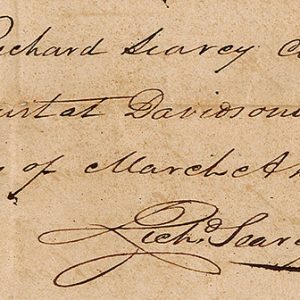calsfoundation@cals.org
Richard Searcy (1794–1832)
Richard Searcy is an often-overlooked figure of Arkansas’s territorial period who helped in the founding and organization of the first county seats in Lawrence and Independence counties. He worked in various positions and professions to serve the people and the Territory of Arkansas, such as secretary for the Arkansas territorial legislature in 1820, county clerk to Lawrence and Independence counties, judge in the First Judicial District (which included Lawrence, Independence, Phillips, and Arkansas counties), postmaster at Davidsonville (Lawrence County), and lawyer based in Batesville (Independence County).
Richard Searcy was born on September 1, 1794, in Sumner County, Tennessee, to Reuben Searcy and his second wife, Elizabeth Jett. He was his father’s sixteenth of seventeen living children and his mother’s seventh of eight children. Little is known about Searcy’s childhood and education except that he was a second-generation American who grew up around a large circle of family and friends dedicated to various forms of civil service and land speculation. Along with working in land speculation, his father served as a vestryman for the Granville Parish in 1758; was the sheriff in Granville County, North Carolina, in the 1760s; and served as the Granville County clerk from 1771 to 1783 before relocating first to Boonesborough, Kentucky, and then to Sumner County, Tennessee. Some of Searcy’s brothers also served as civil servants and lawyers in their respective communities. Although no record exists of him receiving formal legal training, it is likely that he received most of his education using the knowledge and libraries of friends and family members involved in civil service and the law.
Searcy arrived in Lawrence County at Davidsonville, then in Missouri Territory, in 1816, around the age of twenty-one, serving as an agent for his older half-brother William Searcy. Richard Searcy’s signature with the designation as county clerk for Lawrence County appears in records as early as December 23, 1816.
Searcy was heavily involved in founding the town of Batesville as the county seat of Independence County. On February 23, 1821, he was a witness, along with Joseph Hardin, to the purchase of the land from Robert Bean on which the town was founded. He recorded the deed in the deed book under his private seal, as the county office did not have one. On March 23, 1822, the apportionment of the town of Batesville was recorded with Richard Searcy, Joseph Hardin, Charles Kelly, and Thomas Curran as owners and proprietors of the town. Searcy is listed in the apportionment of the town as owning twenty-eight of the town lots.
In December 1821, Searcy was appointed as judge of the circuit court in the First Judicial District; however, by November 1825, he resigned from this position to focus on his law practice. In 1827 and again in 1829, he campaigned to be the congressional delegate to the U.S. Congress. Despite winning his home counties and several others, he was defeated both times by Ambrose H. Sevier.
Searcy died at the age of thirty-eight, on December 25, 1832, in Batesville and is buried in the Pioneer Cemetery there. At the time of his death, he owned a home off the public square in Batesville and approximately 2,000 acres of land across Arkansas and adjoining states or territories. He never married, but he was a well-off man with a lot of property and plenty of family to inherit from him. He owned ten slaves.
On November 5, 1835, the Territorial Legislature of Arkansas named Searcy County in his honor but changed it to Marion County a year later. In 1838, when Marion County was split, the newly created county was again given the name Searcy, to honor a “worthy and good citizen.” On November 23, 1837, the Arkansas General Assembly named the county seat of White County in honor of Richard Searcy.
For additional information:
Austin, Brad. “Richard Searcy: An Arkansas Leader.” April 1994. Family History Folders. Old Independence Museum, Batesville, Arkansas.
Gould, Joan. “A Legacy Lingering Too Long in the Shadows, Part 1.” Independence County Chronicle 59 (January 2018): 6–15.
———. “Richard Searcy: A Legacy Lingering Too Long in the Shadows (II).” Independence County Chronicle 59 (July 2018): 8–18.
Territorial Arkansas Collection. Arkansas Digital Ark-ives. Arkansas State Archives. http://ahc.digital-ar.org/cdm/search/collection/p16790coll6 (accessed July 3, 2018).
Erica Eaves
Arkansas State Archives – NEARA
 Law
Law Louisiana Purchase through Early Statehood, 1803 through 1860
Louisiana Purchase through Early Statehood, 1803 through 1860 Politics and Government
Politics and Government Richard Searcy Signature
Richard Searcy Signature 




Comments
No comments on this entry yet.